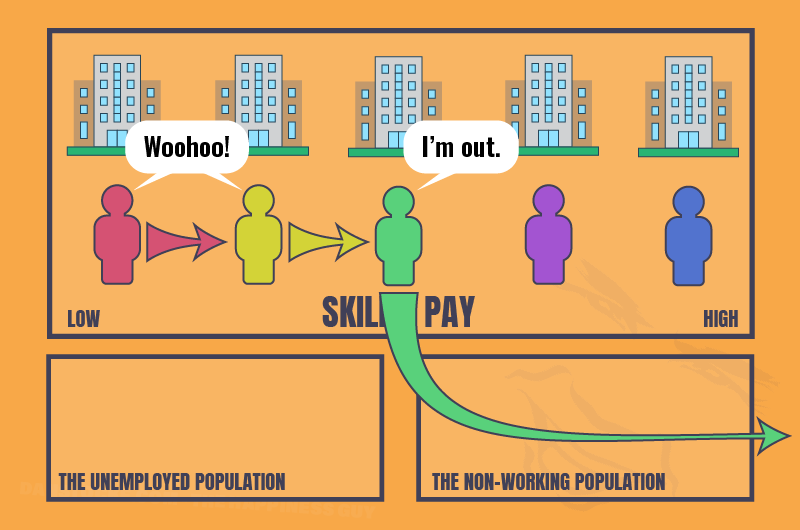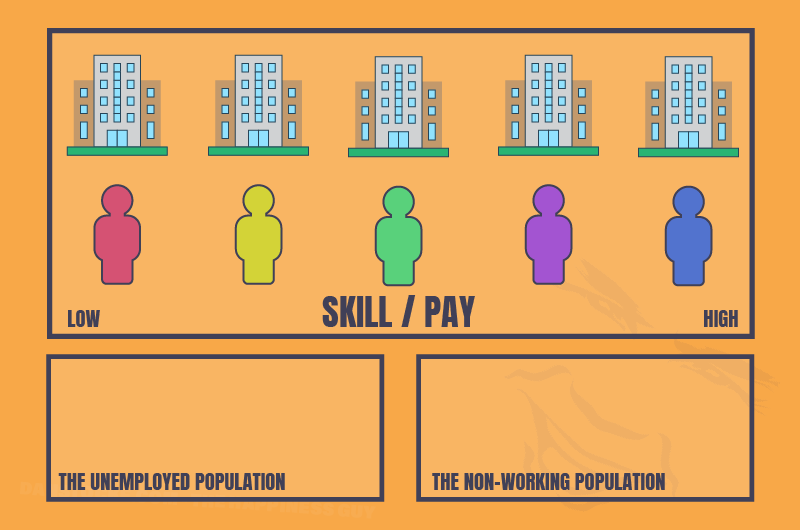"No One Wants to Work?" Nah, They’re Already Working
Boomers Are Retiring, Immigrants Are Blocked—Who’s Gonna Fix Your Toilet?
Part of a random series of getting to the truth by simplifying the info and taking it to extremes.
Let’s say there is a community where there are exactly five jobs; one of which is a high-skill and high-paying and thus a desirable job, on the other end there is one job that is low-skill and low-paying. The other three jobs fit equally between those two extremes. Let us also say that there are exactly five people in this town that fit the skill levels perfectly and therefore each have a job that pays to their skill level. Everyone who can work is working and unemployment levels are at an historic low.
What happens when someone moves out of town? Ooh, a job becomes available. Of course, it is only desirable to those for whom it is an upgrade to their current position. If the middle person leaves, only the two people with lower-skill, lower-pay jobs will apply. Assuming they are at least reasonably qualified, they’ll each get a promotion.
Now there are only four people in town and there are still five jobs. Everyone who can work is working and unemployment levels are still historically low. But whatever job is no longer being fulfilled is having an impact on the rest of the population. If that job is picking lettuce, then this community will no longer have lettuce. If that job was mowing lawns, then this community is going to have long grass. (I am not suggesting these services aren’t worthy jobs - they are very worthy jobs - but for this thought process they are good examples).
In this situation there is only one way to fill that job and that is for the job to pay more. When that happens not only is there still an unfulfilled job in the community, but the added cost of labor increases the price of whatever they were doing. It means lettuce prices will go up. It means it will cost more to get your lawn mowed.
And still, everyone is working and unemployment remains historically low.
SO WHAT?
The United States is currently experiencing historically low unemployment and has been adding jobs at a pretty decent clip the past few years1. When anyone says something along the lines of “no one wants to work anymore these days,” remind them that it’s not that no one wants to work, it's that they are already working.
When we have a lot of jobs and yet everyone already has a job it is much like our little community when someone leaves: jobs will need to pay more to entice workers to come work there and the price of that good or service will increase. Low unemployment + job creation = inflation2.
There are two other rather seismic phenomena that will only exacerbate what is already happening: The Silver Tsunami and the clamp down on immigration. To explain, let’s start from square one again:
1) THE SILVER TSUNAMI
The Boomer Generation is retiring (and dying) en masse right now. The giant wave of population that has been in the workforce for the past 40-50+ years is about to leave their jobs in an equally crashing wave. About 10,000 Boomers are reaching retirement age every day and that wave is going to peak around 2028 (The pandemic may have sped up that timeline). Gen X, that came up behind them, doesn’t have the population to replace them and the Millennials and younger don’t have the experience3.
Many of these Boomers work in the trades: electricians, plumbers, welders, and HVAC techs. When they leave, the cost of whatever it was they were doing is about to go up considerably because whoever IS available to replace them is going to need the training to do so. In our community it is like someone dropped out of the job market, but the next person in line wasn’t qualified for the job.
Unemployment is still very low, but now we have someone living their golden years in the non-working population (congratulations).
2) CLAMPING DOWN ON IMMIGRATION
Immigrants - particularly unauthorized immigrants - play the role of filling in holes in our employment landscape, especially those jobs that most people do not want4: farming, construction, food prep, cleaning and maintenance, and landscaping. The restriction of immigration and/or deportation of these members of the workforce put a strain on everything else.
In our little community it’s much like our first scenario when the middle person moved out of town, except this time no one had the opportunity to move up. The lowest-skilled, lowest-paid worker just simply vanished - along with whatever job they were doing.
The laws of supply and demand are now wildly out of whack between workers and jobs. There is a strong demand for people to do the work, but there isn’t enough supply of people to fill the vacancies. And our little community is starting to look like a ghost town.
And therein lies the real threat. If the amount of jobs outstrips the amount of people available to do those jobs, hard choices are going to need to be made about what jobs are the ones we want to keep around. Is being able to buy reasonably priced food important? Is being able to have a working toilet installed in your new home important?
If the answer to those questions is “yes,” then we really need to figure out where all this labor is going to come from or be willing to pay the price.
U.S. Bureau Of Labor Statistics Employment Situation Summary
What is the Silver Tsunami and How Do You Deal with It?
A majority of Americans say immigrants mostly fill jobs U.S. citizens do not want














The obvious solution is to import some workers. That's what we did up here in Canada. And surprise. Everything is still working. Some people are unhappy about the new Canadians, but we can still go to Tim Horton's and get a coffee because the new people will take that job that the "real" Canadians won't do because they are (you said it) already working at a better rate.
Either Tim Hortons needs to charge a ton more and pay more to hire locals (who will then stop welding and mechanic-ing and lawyer-ing and whatnot), or we keep importing workers. And a coffee will cost $10. It's simple math.